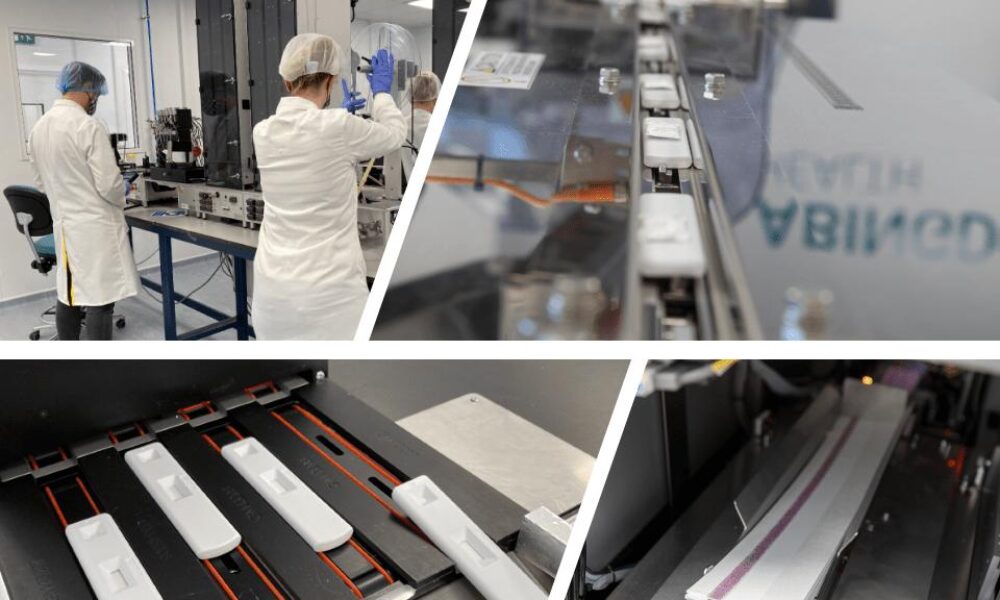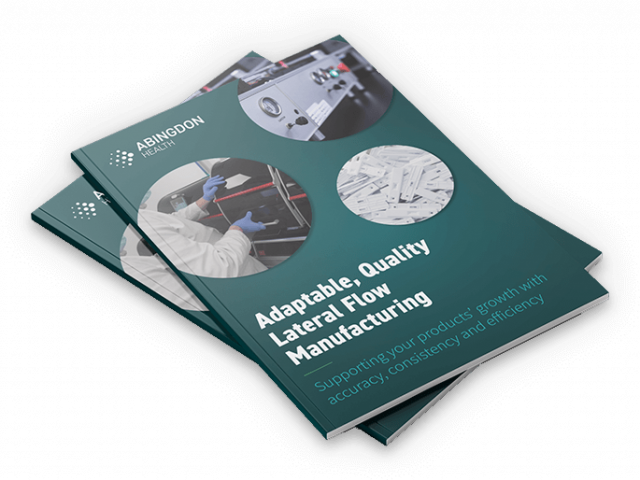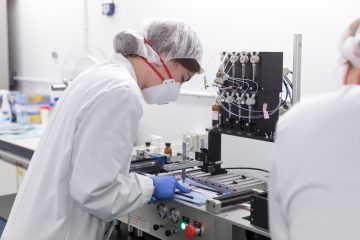Overcoming Common LFT Manufacturing Technical Transfer and Scale-up issues

LFT Production: Technical Transfer and Scale-Up
Key Areas of Technical Transfer and Scale-Up
Market Challenges and Opportunities
Conclusion
In latest of our lateral flow test (LFT) manufacturing articles, Abingdon Health’s Chief Operation Officer, Mark Jones, discusses some of the common technical challenges enroute to routine LFT manufacture.
Interest in lateral flow test technology has increased because of the COVID-19 pandemic. With greater consumer and end-user awareness of LFTs being a major factor why companies across multiple industries want to innovate further in this space. So much so, revenue-growth in the lateral flow test market is expected to reach USD $12.6bn by 2027. Up from $8.5bn in 2021.1
Meeting this demand will require companies to plan-for and carryout many activities relating to R&D, scale-up, manufacturing, commercialisation; the list goes on. Read our lateral flow test manufacturing blogs for information on this. However, for this article, I will focus on overcoming common issues when trying scale-up a R&D-ready lateral flow test into routine production.
LFT Production: Technical Transfer and Scale-Up
Designing a robust lateral flow test specification that can cope with high-volume manufacture requires skill and experience, and of course the ability to meet production demands. However, the key element here is the experience. LFTs, although mostly the same in appearance, are very different internally. Each test will have its own specific mixture of reagents, nitrocellulose membranes and backing card grades, for example. Some will have filters, others will not, and sampling and sample matrices will vary from test to test. Meaning there are possibly a variety of different scale-up challenges.
Planning early for technical transfer and scale-up during LFT product development will pay dividends for your project. It allows you to outline a list of important considerations and track them. For example, are future supply chains secure, and which quality materials are commercially available at scale and able to cope with high-volume production, or indeed, meet applicable regulations.
This is where good contract manufacturing organisations (CMO) excel and use in-house know-how, infrastructure, and capacity to take an LFT from small-scale to large-scale production.
Key Areas of Technical Transfer and Scale-Up
When scaling up and transferring your product into routine production there are several key areas to address:
Equipment
- Compatibility of your manufacturing process with high-volume production equipment needs to be considered early in your design process. Common mistakes are to optimise and design your manufacturing processes for small scale equipment and to miss key development steps which are required for scaled-up manufacturing. Scaled-up manufacturing is the key output to yield cost per unit benefits. Not taking this into consideration early in your product development cycle can lead to delays and a lack of robustness in your product and manufacturing process.
 Facilities
Facilities
- Ensuring environmental and facility controls are in line with your manufacturing specifications can be overlooked. There are several key environmental controls required throughout the process of manufacturing an LFT at scale. Failure to do so can lead to expensive CAPEX (Capital Expenditure) requirements late in the design control process.
Methods
- Manufacturing specifications are the culmination of your assay development work and need to encompass a thorough assessment of your critical process parameters. Production steps can often be overlooked as not being critical to the process and this assumption can lead to product failures and manufacturing delays.
- Quality control specifications and statistical rationales for your product testing approach are often neglected in favour of a focus on the production methodologies. The quality control rationale is a vital part of your product development programme, as success here will lead to successful-product-release. In doing so, you will have confidence you are releasing product into the market which consistently achieves product claims.
 Training
Training
- Knowledge transfer of the manufacturing specifications from your core group of experts into the manufacturing group is a key element of your project planning. Abingdon Health have a successful track record of managing this knowledge transfer process during internal specification training.
Materials
- Understanding your key raw material and having successful supply routes backed up with supply agreements is key to success. Having a robust supplier selection and approval process will pay dividends in your long term manufacturing success as you will be selecting robust suppliers at an early stage of your product development cycle.
If these areas are addressed in a diligent and robust manner, then you are on the right path to successfully scale up and transfer your product into routine LFT manufacturing. The advantage of working with a contract manufacturer means that most of what is discussed above is second-nature and part of the routine working day.
Market Challenges and Opportunities
Overcoming common manufacturing issues is one thing but overcoming market challenges and hitting the strategic ambitions is another. Both come with their respective infrastructure, resourcing, and financial commitments. And the route to achieving return-on-investment can be lengthy.
Following the commercial-instability of the COVID-19 pandemic and the emergence of increasing uncertain geopolitical events, all industries are finding it difficult to predict the next major threat. Therefore, businesses are more likely to protect their value by adopting models that achieve strategic objectives through secure supply chains and rationalised expenditure models. In the case of the growing lateral flow test industry, long-established CMOs are offering a safe pair of hands that businesses need. Therefore, in a recent article, ‘To outsource or not outsource – Is it really a question?’ we discuss why working with an experienced CMO in an increasingly competitive market helps assure business continuity and optimum output.
Conclusion
Technical transfer and scale-up is the most critical part of taking an LFT from R&D into routine manufacture. It is this phase that makes or breaks any chance of commercialisation. LFT production in low volumes is very different from high-volume manufacturing, and the transition between the two is not always straightforward.
There are several considerations to completing a lateral flow test scale-up project. It doesn’t matter whether you manufacture in-house, already work with a CMO or new to the lateral flow market, I urge you to focus on technical transfer and scale-up. Do it as early as possible and do not release your scale-up-focus until the test is rolling off the production line in large batches, on-time and in-full (OTIF).
Innovators look to develop lateral flow tests to meet an unmet or growing need, all with the aim of making a difference for the end-users. When taking the risk and time to research and develop a lateral flow test, there needs to be a good chance the LFT project will result in routine manufacture. Hence why a laser-like focus on the end-goal needs to remain throughout a project.
 Whether you are an established player or emerging innovator, a good lateral flow test CMO will lead you through the LFT scale-up process, while being a safety net in supporting your success. Contact Abingdon Health for a no-obligation and confidential consultation to see how we can help you on your journey.
Whether you are an established player or emerging innovator, a good lateral flow test CMO will lead you through the LFT scale-up process, while being a safety net in supporting your success. Contact Abingdon Health for a no-obligation and confidential consultation to see how we can help you on your journey.




